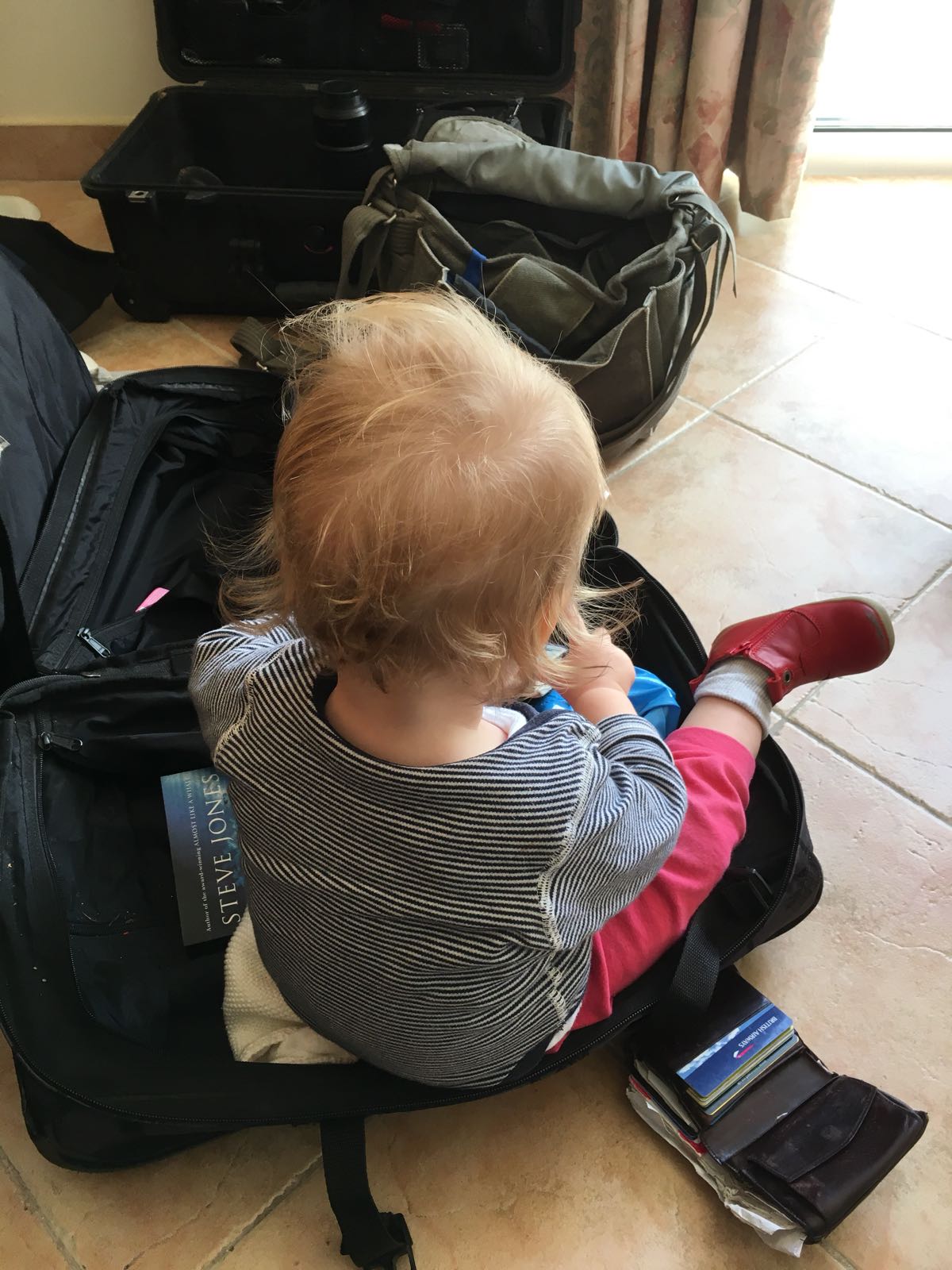Travelling a lot for work, I prefer to spend as little time packing – or thinking about packing – as possible. Nerdy though it may sound, I never start the process without consulting one of several packing lists – city break, hot climate, cold climate, hiking, scuba diving, etc. And now, this baby packing list too.
The baby girl was four-weeks-old the first time we went away with her, to a cottage in Wales to celebrate my mother-in-law’s 70th birthday over a long weekend. For the first time in a long time, I didn’t have a packing list for the task at hand. After a chaotic day and night throwing baby stuff into various receptacles almost at random, we managed to hit the road. My partner driving, I immediately set about writing a list.
Here it is, more tidily laid out than in the original version on my phone, and with a few annotations. I hope you find it useful. If there’s anything I’ve missed, please add your own packing essentials in the comments (I’ll be doing a separate post on travelling in hot climates – if you want advice about what to pack for a hot climate trip in the meantime, drop me a line in the comments below).
Baby monitor
Or a spare phone or tablet if you’re using the Baby Monitor 3G app (for more information on why this is a brilliant thing, here’s my recent ‘essential kit’ post about it).
Baby nail clippers
Baby sleeping bag
Bathroom stuff
Bath additive, baby shampoo, toothbrush, baby toothpaste.
Blankets
Something warm, plus one you don’t mind getting grubby that you can use for sitting on when out and about.
Car seat
Plus adaptors if you have a ‘travel system’ pushchair.
Clothes
Two complete outfits (vest + sleepsuit + sweater; or vest + trousers + top + sweater) per day, snow suit/coat, hat and spare; socks; shoes.
Documents
Passport (here’s how to apply for one for your child), visa, birth certificate, consent letter (if appropriate – here’s more information), Personal Child Health Record (‘red book’).
First aid kit
Including thermometer and painkillers (Calpol, ibuprofen, teething gel).
Baby paddling pool
See my post ‘Essential kit: inflatable paddling pool’ for why you don’t want to leave home without one of these.
Muslin squares
For swaddling, cleaning up, and as comforters.
Nappies
8-12 nappies per 24 hours away, depending how much your baby is pooing in the days leading up to your departure. You can almost always buy nappies where you’re staying, but if you’re travelling with a very small baby, or are going somewhere remote, better to be safe than sorry and take enough from home to last you for the whole trip.
Nappy wallet and change mat
Including nappy sacks, nappy rash cream and hand sanitiser.
Night light
Pram/pushchair
Sunshade for napping, plus a bag of some kind to pack the pushchair into if you’re flying. We have the official travel bag (bought on eBay) for our Bugaboo Bee (also eBay), which is excellent because it protects the pushchair from being chucked around by baggage handlers and also gives you extra space to stow baby stuff. If you don’t want to buy the official version for your pushchair, there are generics available. But go for one with wheels and/or backpack straps if possible. In a pinch you can use a heavy duty bin liner for each bit of the pushchair (and remember to pack extras for the return journey).
Sling
My ‘essential kit’ post on slings covers some of the different options available.
Toys and books
Travel cot/tent/bassinet
Having been on a couple of trips now where the cot provided hasn’t been fit for purpose, I highly recommend bringing one of your own.
Wipes
One pack of wipes per 72 hours away. Though you can buy baby wipes when you arrive, the options might be pretty rubbish – very highly scented, for example, or not suitable for sensitive skin – so if you’re fussy about these things, just bring a couple of extra packets from home.
*Optional extras depending on you and your baby*
Breast pump
Dribble bibs
Dummies
Teething rings
Bone-conducting headphones
These are a must for me – find out why in my ‘essential kit’ post all about them.
*If breastfeeding*
Folding sock airer
See laundry detergent below.
Laundry detergent
A small quantity for hand washing milk-soaked bras (and nursing pads, if you use washables).
Nursing bras
Including a couple comfortable enough to sleep in if you’re still at the stage of needing to wear a bra and nursing pads to bed.
Nursing pads
Take more than you think you might need in case the disruption of travel makes your baby feed more frequently, thereby causing your breasts to leak more than usual.
*If bottlefeeding (whether formula, expressed breastmilk or a combination of the two)*
Bibs
Bottles, etc
Bottle brush
Cold sterilising tablets or liquid
Only necessary until your baby is a year old – see my post ‘Travel sterilising tips for new parents’.
Formula
Washing-up liquid
*If your child is eating solids*
Baby food in jars or pouches for emergencies
Plus any type of food you really couldn’t live without while you’re away. The baby girl is a bit of a fussy eater at the moment, but will always polish off a big bowl of porridge for breakfast, so we take a small Tupperware container of oats away with us if we’re self-catering just in case we can’t find any locally at our destination.
Baby/toddler spoons
Bibs/smocks
Laundry detergent
A small quantity for washing bibs so you don’t have to pack one for every meal.
Snacks
Travel high chair
I cover the various kinds available in my post on eating out with babies and toddlers.
Tupperware
One or two small ones so you’re able to feed your child with food from home when out and about.


